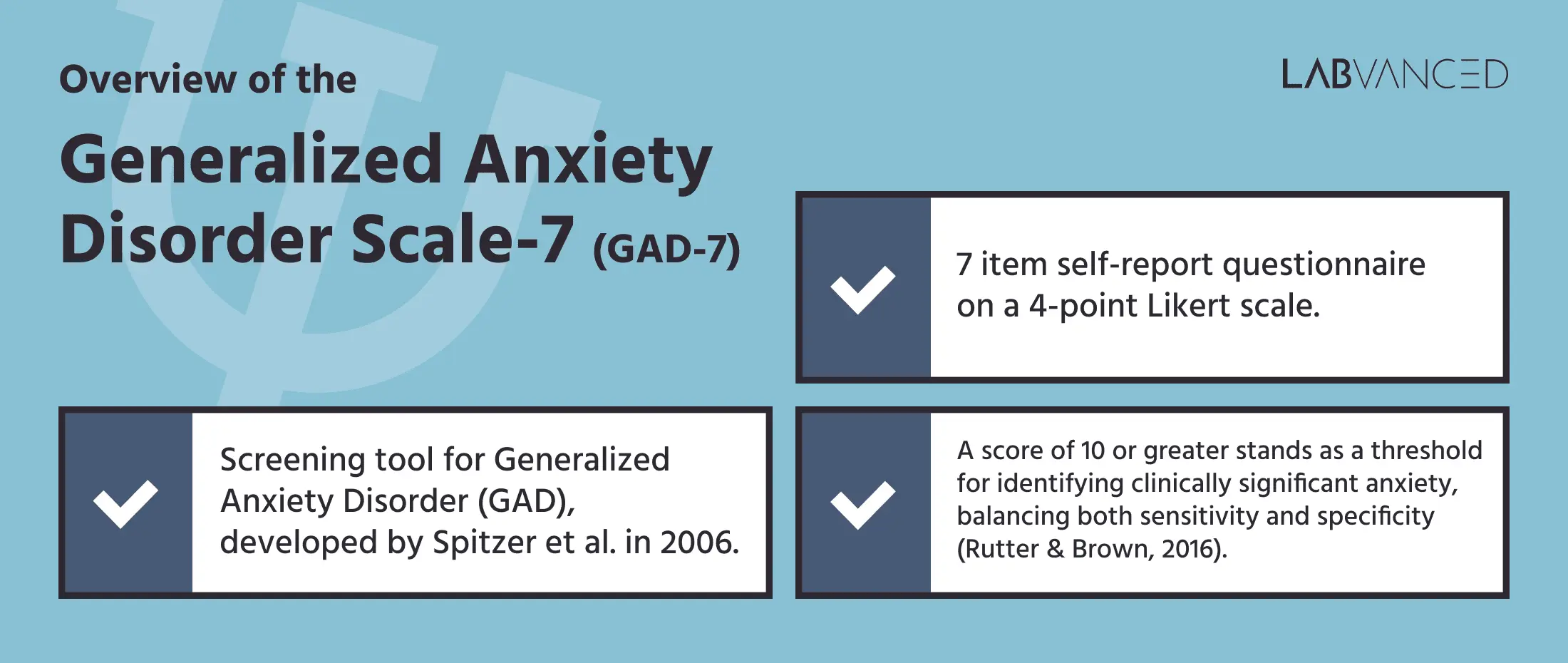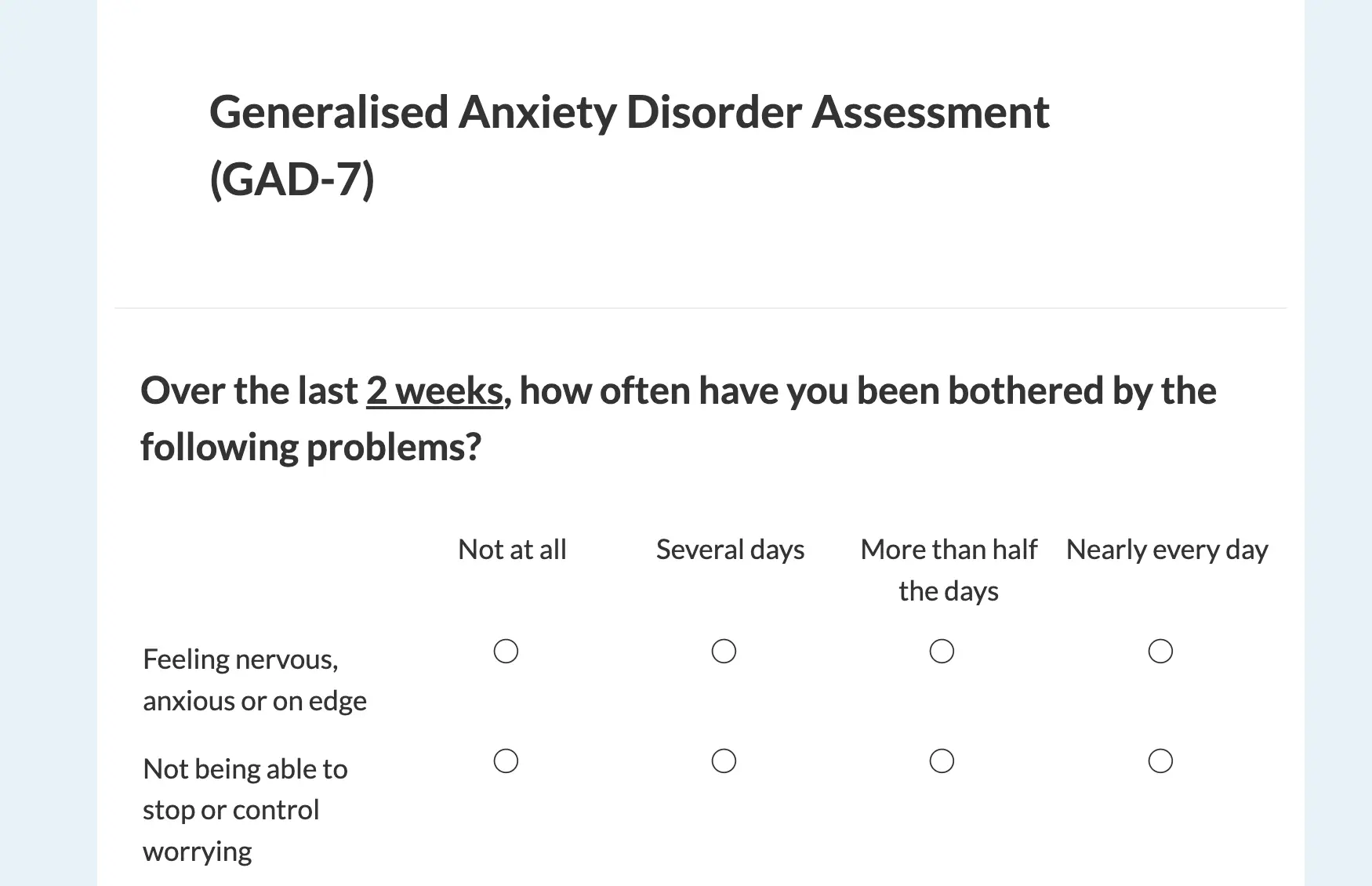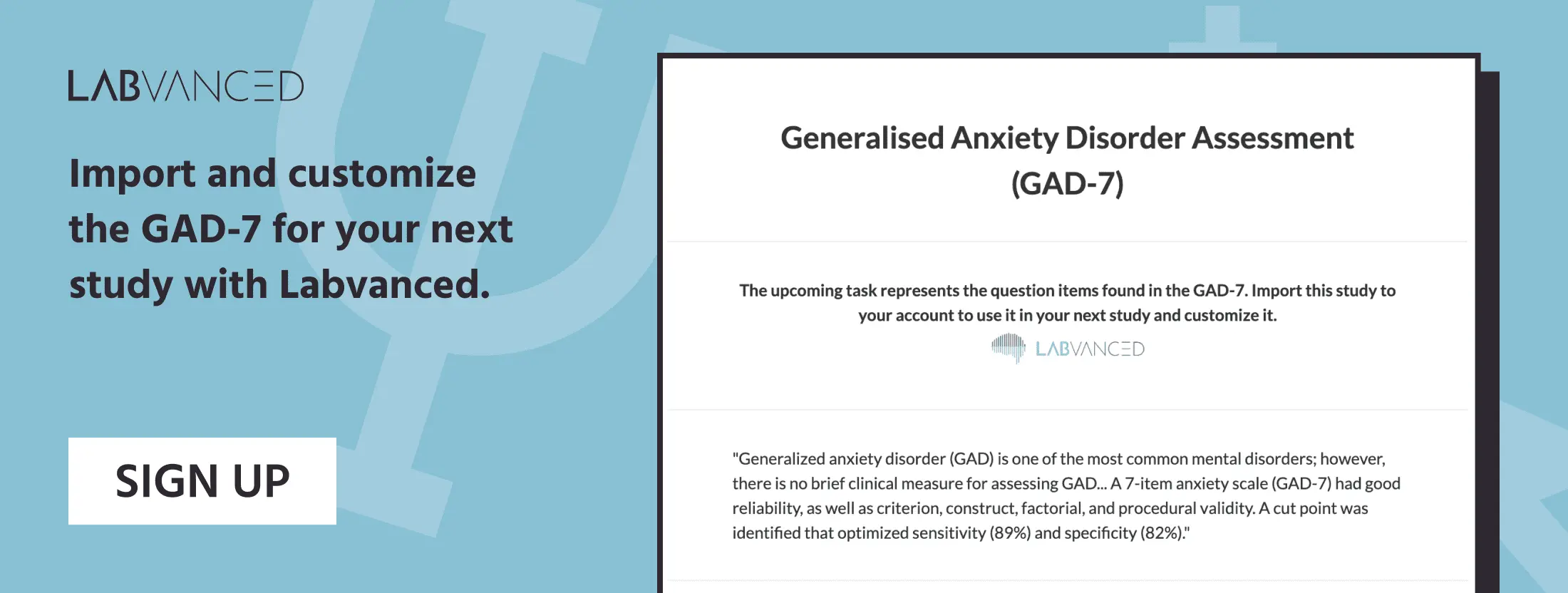
Generalized Anxiety Disorder Scale-7 (GAD-7)
The Generalized Anxiety Disorder Scale-7 (GAD-7) is a brief self-report scale that is used to screen for GAD, a mental health disorder characterised by excessive and constant worrying about a variety of topics (eg., school, work, finances). It also effectively evaluates the severity of symptoms associated with it. Known for its excellent psychometric properties, GAD-7 is widely used across different populations and is also adapted into multiple languages.

History of the the GAD-7
The GAD-7 was developed by Spitzer and his colleagues in 2006. They recognized that the already existing measures of anxiety had many limitations, such as their length, ownership nature, lack of practicality, and the need for a clinician for test administration. This highlighted the need for a shorter instrument for screening and measuring the severity of generalized anxiety disorder (GAD) that could also be self-administered. Thus, the GAD-7 was developed.
The scale originally consisted of 13 items based on the diagnostic criteria for GAD outlined in the Diagnostic and Statistical Manual of Mental Disorders, 4th Edition (DSM-IV). These items were correlated with the total score of the scale, and the seven highest correlated items were chosen for the final version of the scale, thus the name GAD-7 (Spitzer et al., 2006).
The GAD-7 was first validated in a primary healthcare setting. Since then it has been found to have excellent psychometric properties across various samples and settings and the GAD-7 is even administered online. It has also been translated into multiple languages (Rutter & Brown, 2016). The GAD is now widely used in remote health surveys, epidemiologic studies, and also in primary care settings (Sapra, 2020).
Structure of the Questionnaire
The Generalized Anxiety Disorder Scale-7 is a brief questionnaire consisting of 7 items on a 4-point Likert scale. Each of these items correspond to the symptoms of anxiety as per DSM-IV. The seven items comprising the GAD-7, for which respondents must rate themselves, are presented as follows:
- Feeling nervous, anxious, or on edge
- Ability to control worrying
- Excessive worrying about different things
- Difficulty relaxing
- Restlessness
- Irritability
- Fear that something awful might happen (Johnson et al., 2019; Nunes et al., 2022).
The respondents are expected to indicate on the 4-point Likert scale how often, during the past two weeks, they were bothered by each symptom. The response options are “not at all,” “several days,” “more than half the days,” and “nearly every day,” with each scored as 0, 1, 2, and 3, respectively. (Spitzer et al., 2006).

The GAD-7 questionnaire, as shown above, can be imported to your Labvanced account and then edited by clicking on the ‘Import’ button here.
GAD-7 Scoring
Since the GAD-7 consists of 7 items with each item scored from 0 to 3, the total score ranges from 0 to 21. A score of 10 or greater stands as a threshold for identifying clinically significant anxiety, balancing both sensitivity and specificity (Rutter & Brown, 2016).
The following cut-offs correlate with level of anxiety severity (Sapra, 2020):
- Score 0-4: Minimal Anxiety
- Score 5-9: Mild Anxiety
- Score 10-14: Moderate Anxiety
- Score 15 or greater: Severe Anxiety

The GAD- 7 in Research
The GAD-7 is a valid and efficient tool for screening and assessing the severity of GAD. Since its development, researchers have adapted and tested the scale in various groups, and it continues to be widely used. Here are some examples of how the questionnaire is incorporated in research across various fields, groups and populations:
General Population: In the study, the GAD-7 was used to assess anxiety levels in a general population sample of over 5,000 participants in Germany. The findings indicated that the GAD-7 showed strong reliability and construct validity, with a uni-dimensional structure that was consistent across different age and gender groups. The study also found that scores of GAD-7 in the general population were generally lower as compared to those in clinical settings, implying its effectiveness as a screening tool for anxiety in non-clinical populations too (Löwe et al., 2008).
Sports psychology: In a study, the GAD-7 was used to assess anxiety and other mental health concerns among a national sample of over 7,500 student-athletes in the United States. The GAD-7 showed that higher anxiety levels were associated with more functional and academic difficulties, poorer perceived mental health, and lower positive mental health, supporting its effectiveness for anxiety screening and mental health assessment in student-athletes (Tran, 2020).
Pregnant Women: Zhong et al. (2015) utilized the GAD-7 as a screening tool to assess generalized anxiety disorder (GAD) among pregnant women in Peru. The study involved 2,978 women who completed the GAD-7 questionnaire during their first perinatal care visit. The Spanish-language version of the GAD-7 used in this study was found to be a reliable and valid tool for screening GAD in pregnant women.
Autism: The efforts to test GAD-7 across various clinical populations have led to researchers exploring its reliability for identifying anxiety in individuals with autism spectrum disorder (ASD). While it is still unknown whether the GAD-7 is reliable and valid for all autistic populations, including those that experience intellectual disabilities, this avenue of research seems to be capturing the interest of clinical psychologists given that autistic individuals may experience anxiety differently (El Baou, C., 2023).
Individuals with epilepsy: In a paper by Tong et al., (2016), the Generalized Anxiety Disorder-7 (GAD-7) was utilized as a screening tool to assess generalized anxiety disorder (GAD) among Chinese people with epilepsy. The study involved a group of 213 participants and the findings suggested that using the GAD-7 can facilitate earlier detection and appropriate intervention for anxiety in individuals with epilepsy.
Individuals with addiction: In a study interested in assessing anxiety in individuals with addiction, the GAD-7 was utilized to assess anxiety disorders among participants in a community drugs treatment service. The study aimed to evaluate the diagnostic accuracy of the GAD-7 in comparison to the CIS-R (Clinical Interview Schedule-Revised). The findings supported the use of GAD-7 as an effective screening measure for identifying anxiety disorders in individuals undergoing addiction treatment (Delgadillo et al., 2012).
Migraine patients: In a study conducted by Seo & Park (2015), the researchers set out to determine whether the Generalized Anxiety Disorder-7 (GAD-7) was a reliable questionnaire that can be utilized as a rapid screening tool to identify anxiety levels in patients who suffer from migraines and are seeking treatment. The study involved 146 eligible patients and the study concluded by stating the GAD-7 to be an invaluable instrument that can be used for efficiently identifying anxiety in migraine patients, facilitating timely recognition and management of anxiety disorders in this population.
Conclusion
The Generalized Anxiety Disorder Scale-7 (GAD-7) stands as a highly effective tool for screening, assessing, and monitoring GAD in individuals in a simple and efficient manner. Its brief and self-report nature has made it a prominent choice for both diagnostic and research purposes. Since its creation, the GAD-7 has been translated into multiple languages and continues to be used globally. By facilitating early detection and intervention, the GAD-7 contributes significantly to improving mental health outcomes and enhancing the quality of care worldwide!

References
Delgadillo, J., Payne, S., Gilbody, S., Godfrey, C., Gore, S., Jessop, D., & Dale, V. (2012). Brief case finding tools for anxiety disorders: Validation of GAD-7 and Gad-2 in addictions treatment. Drug and Alcohol Dependence, 125(1–2), 37–42. https://doi.org/10.1016/j.drugalcdep.2012.03.011
El Baou, C., Bell, G., Saunders, R., Buckman, J. E., Mandy, W., Dagnan, D., ... & Stott, J. (2023). Effectiveness of primary care psychological therapy services for treating depression and anxiety in autistic adults in England: a retrospective, matched, observational cohort study of national health-care records. The Lancet Psychiatry, 10(12), 944-954.
Johnson, S. U., Ulvenes, P. G., Øktedalen, T., & Hoffart, A. (2019). Psychometric Properties of the general anxiety disorder 7-item (GAD-7) scale in a heterogeneous psychiatric sample. Frontiers in Psychology, 10. https://doi.org/10.3389/fpsyg.2019.01713
Löwe, B., Decker, O., Müller, S., Brähler, E., Schellberg, D., Herzog, W., & Herzberg, P. Y. (2008). Validation and standardization of the Generalized Anxiety Disorder Screener (GAD-7) in the general population. Medical Care, 46(3), 266–274. https://doi.org/10.1097/mlr.0b013e318160d093
Nunes, J. C., Carroll, M. K., Mahaffey, K. W., Califf, R. M., Doraiswamy, P. M., Short, S., Shah, S. H., Swope, S., Williams, D., Hernandez, A. F., & Hong, D. S. (2022). General anxiety disorder-7 questionnaire as a marker of low socioeconomic status and inequity. Journal of Affective Disorders, 317, 287–297. https://doi.org/10.1016/j.jad.2022.08.085
Rutter, L. A., & Brown, T. A. (2016). Psychometric properties of the Generalized Anxiety Disorder Scale-7 (GAD-7) in outpatients with anxiety and mood disorders. Journal of Psychopathology and Behavioral Assessment, 39(1), 140–146. https://doi.org/10.1007/s10862-016-9571-9
Sapra, A., Bhandari, P., Sharma, S., Chanpura, T., & Lopp, L. (2020). Using generalized anxiety disorder-2 (GAD-2) and gad-7 in a primary care setting. Cureus. https://doi.org/10.7759/cureus.8224
Seo, J.-G., & Park, S.-P. (2015). Validation of the generalized anxiety disorder-7 (GAD-7) and Gad-2 in patients with Migraine. The Journal of Headache and Pain, 16(1). https://doi.org/10.1186/s10194-015-0583-8
Spitzer, R. L., Kroenke, K., Williams, J. B., & Löwe, B. (2006). A brief measure for assessing generalized anxiety disorder. Archives of Internal Medicine, 166(10), 1092. https://doi.org/10.1001/archinte.166.10.1092
Tong, X., An, D., McGonigal, A., Park, S.-P., & Zhou, D. (2016). Validation of the generalized anxiety disorder-7 (GAD-7) among Chinese people with epilepsy. Epilepsy Research, 120, 31–36. https://doi.org/10.1016/j.eplepsyres.2015.11.019
Tran, A. G. T. T. (2020). Using the GAD-7 and gad-2 generalized anxiety disorder screeners with student-athletes: Empirical and clinical perspectives. The Sport Psychologist, 34(4), 300–309. https://doi.org/10.1123/tsp.2020-0028
Zhong, Q.-Y., Gelaye, B., Zaslavsky, A. M., Fann, J. R., Rondon, M. B., Sánchez, S. E., & Williams, M. A. (2015). Diagnostic validity of the Generalized Anxiety Disorder - 7 (GAD-7) among pregnant women. PLOS ONE, 10(4). https://doi.org/10.1371/journal.pone.0125096